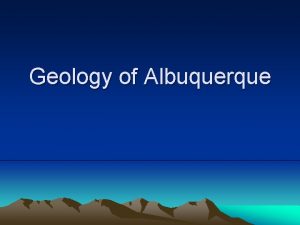Londons geology overview This set of slides will













- Slides: 13

London’s geology overview • This set of slides will help you to visualise London’s geological setting and to learn more about the rock types and how they have influenced London. • There also slides to help you understand how the London area has been affected by the Ice Age.

Overview of the London area Chalk (formed from 100 to 66 million years ago) http: //commons. wikimedia. org/wiki/File: Geological_map_of_London_ Basin. jpg? uselang=en-gb London Clay (formed from 56 to 34 million years ago) The chalk was originally laid down horizontally, but was folded during the formation of the Alps. The down-fold makes the ‘syncline’ of the London Basin. The thick line represents a cross-section through the rocks, depicted in the simplified drawing here: North Downs Chilterns London Clay older rocks chalk

Overview of the London area • This is a more detailed cross-section to compare with the simple drawing on the previous slide. London Chalk British Geological Survey

Chalk • Chalk is a fine grained limestone formed from the calcite shells of microscopic phytoplankton called Coccolithophores which pile up on the sea floor. • It forms in warm, clear tropical seas. • Chalk also contains flint nodules. • A famous exposure of chalk is the White Cliffs of Dover. • It is a porous, sedimentary rock which can hold water. • This type of rock is found at 70 metres depth under the Palace of Westminster. White Cliffs of Dover http: //commons. wikimedia. org/wiki/File: White_Cliffs_of_Dover_01. JP G? uselang=en-gb (Immanuel Giel) coccoliths seen with a scanning electron microscope http: //commons. wikimedia. org/wiki/File: Coccolith_hg. jpg? uselang=en -gb (Hannes Grobe)

London Clay • • • Clay bedrock is a sedimentary deposit made up mostly of clay particles. Clay particles are very small, platelike particles (much smaller than silt or sand) that are slowly deposited in calm water. Clay particles come from chemical weathering of other rocks and are transported to the sea by rivers. Deposits of clay are impermeable (water does not pass easily through them). Various types of clays have long been used for making ceramics and bricks. London Clay is about 45 metres thick under Westminster, and overlies the chalk. In places it’s more than 150 metres thick. A small exposure of London Clay http: //commons. wikimedia. org/wiki/File: Detail_of_cliffs_at_the_Naze _-_geograph. org. uk_-_1187872. jpg? uselang=en-gb (Simon Huguet) Clay particles Seen with a Scanning Electron microscope http: //commons. wikimedia. org/wiki/File: Clay_magnified. jpg? uselang=en-gb (USGS)

More about London Clay • The grey-blue coloured London Clay formed underwater when sea level was higher than now, and the area was near a warm, subtropical coastline. • London Clay is an easy material to tunnel through. • This helped London to build its underground rail network quickly in the late 19 th century. • Another advantage of London Clay is that, clay being impermeable, groundwater does not penetrate into the tunnels. • The London Clay is nearer the ground surface north of the River Thames, and this is why the Tube is much more extensive on the north side of the river compared with the south side.

Notice how most of the London Underground in Greater London is on the north side of the Thames. This is because of the distribution of London Clay. http: //en. wikipedia. org/wiki/London_Underground#mediaviewer/File: London_Underground_with_Greater_London_map. svg

Geological layers of London • If you could dig a hole straight down into the ground starting at St Paul’s Cathedral in London, this is what you find going downwards: – A layer of ‘made ground’ which is just an accumulation of older structures and rubble from earlier times in the City’s history – Layers of sands and gravels (can be several metres thick) dating to the Ice Age, that were deposited by earlier river channels (geologists refer to these as ‘superficial deposits’ because they overlie older, more compacted bedrock) – The London Clay over 30 metres thick under St Paul’s – Layers of sands and clays that are older than the London Clay – The Cretaceous Chalk at about 70 metres depth which extends down for almost 200 metres (For comparison, Nelson’s Column is 52 metres, and the dome of St Paul’s Cathedral is 111 metres high) • Some higher areas of Greater London (such as Greenwich to the south-east and Hampstead to the north) consist of sandstones that formed after the London Clay. http: //commons. wikimedia. org/wiki/Category: St. _P aul%27 s_Cathedral#mediaviewer/File: St_Paul%27 s _Cathedral_-_geograph. org. uk_-_2952893. jpg (David Dixon)

Geological layers of the London • Although the Cretaceous Chalk and the London Clay are thick rock layers immediately under London, these aren’t the only rock layers. • For instance, older rocks underlie the chalk, and other rock layers are found between the chalk and the London Clay, and also between the London Clay and the surface. • You can review the Geological Timescale and see how it relates to London’s geology by visiting London Geodiversity Partnership website http: //www. londongeopartnership. org. uk/londongeology. html • On the Geological Timescale shown at the above link, the chalk formed during the Cretaceous Period, and the London Clay formed during the Eocene Period.

The influence of the Ice Age on London’s geology • During the Quaternary Period (the Ice Age), there were several times when glacier ice expanded and then retreated in the British Isles. • The most recent British ice sheet, shown here, reached its maximum extent around 20, 000 years ago. • The London area was a cold, treeless tundra landscape at this time. http: //www. bgs. ac. uk/discovering. Geology/geology. Of. Britain /ice. Age/home. html? src=top. Nav (British Geological Survey)

The influence of the Ice Age on London’s geology http: //commons. wikimedia. org/wiki/File: Svalbard_tundra. jpg (Billy Lindblom) This is a photograph from Svalbard in the Arctic Circle, but the London area and England south of the British Ice sheet would have looked similar to this.

The influence of the Ice Age on London • An ice sheet reached its furthest southerly extent in Britain about 430, 000 years ago. • A rough boundary of this earlier ice sheet is shown by the thick black line. • Notice that its edge came very close to central London. • The ice sheet edge reached the Finchley area of North London and northernmost parts of the Borough of Havering in eastern London. Extent of ice about 20, 000 years ago Extent of ice about 430, 000 years ago London

The influence of the Ice Age on London • When the ice sheet was near London, a huge amount of meltwater from the edge of the ice caused powerful streams (and the ancient River Thames) to transport and deposit large amounts of sand gravel. • These make the ‘superficial’ layers just beneath the surface in London. • As the River Thames alternately deposited and then cut down through this material, gravel terraces formed. (These are like ‘steps’ of gravel at slightly different elevations in the Thames Valley. ) Many parts of London are built on these various terraces. • For an idea of how sand gravel is moved and deposited from glacial meltwater, go to Swiss Education website photo glossary: http: //www. swisseduc. ch/glaciers/glossary/index-en. html and select ‘outwash plain’ and ‘braided stream’.
 Total set awareness set consideration set
Total set awareness set consideration set Training set validation set test set
Training set validation set test set A small child slides down the four frictionless slides
A small child slides down the four frictionless slides Energy conservation quick check
Energy conservation quick check Let’s start with the first set of slides
Let’s start with the first set of slides Cripsdm
Cripsdm Transition headline
Transition headline Crisp set vs fuzzy set
Crisp set vs fuzzy set Crisp set vs fuzzy set
Crisp set vs fuzzy set Bounded set vs centered set
Bounded set vs centered set What is the overlap of data set 1 and data set 2?
What is the overlap of data set 1 and data set 2? Fuzzy logic
Fuzzy logic Surjective vs injective
Surjective vs injective Entouka meaning
Entouka meaning

























